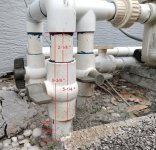After doing some pressure testing yesterday, I discovered that at least two of the three ball valves shown in the attached picture need to be replaced. I had injected water at the union joint with the spa valve open and drain plugged. The one for the spa dripped water at the valve stem but did not seem to be the main cause of the fairly large pressure drop. When I injected air to try and trace an additional leak, I discovered bubbles emerging from the skimmer while it's valve was supposed to be 'fully' closed. I intend to replace all three with true union full flow valves so that any future maintenance or replacement will be straightforward.
My plan is to cut the 1-1/2" pipes immediately above the valve bodies which will allow them to be lifted clear, by disconnecting the union feeding the pump. Then I propose trying to remove the valves by heating the lower section with a hot air gun and twisting them off. The reason for this approach is that there are only 9-3/4 inches between ground level and the bottom of the 3-way assembly and the new valves are approximately 3/4 inch longer than the existing ones. I'm hoping that I won't need to cut any more of the existing pipes in order to fit the new valves but if necessary, it will be easier to trim them from the upper section while it is removed.
After removing the valves, I'll be able to pressure test the spa drain and skimmer lines independently as I've suspected both to have air leaks for some time. Fortunately, the main drain has not given any problems so far.
Has anyone attempted to remove valves this way (heating) and if so, do you have any tips or advice to offer?
Thanks,
Al

My plan is to cut the 1-1/2" pipes immediately above the valve bodies which will allow them to be lifted clear, by disconnecting the union feeding the pump. Then I propose trying to remove the valves by heating the lower section with a hot air gun and twisting them off. The reason for this approach is that there are only 9-3/4 inches between ground level and the bottom of the 3-way assembly and the new valves are approximately 3/4 inch longer than the existing ones. I'm hoping that I won't need to cut any more of the existing pipes in order to fit the new valves but if necessary, it will be easier to trim them from the upper section while it is removed.
After removing the valves, I'll be able to pressure test the spa drain and skimmer lines independently as I've suspected both to have air leaks for some time. Fortunately, the main drain has not given any problems so far.
Has anyone attempted to remove valves this way (heating) and if so, do you have any tips or advice to offer?
Thanks,
Al





